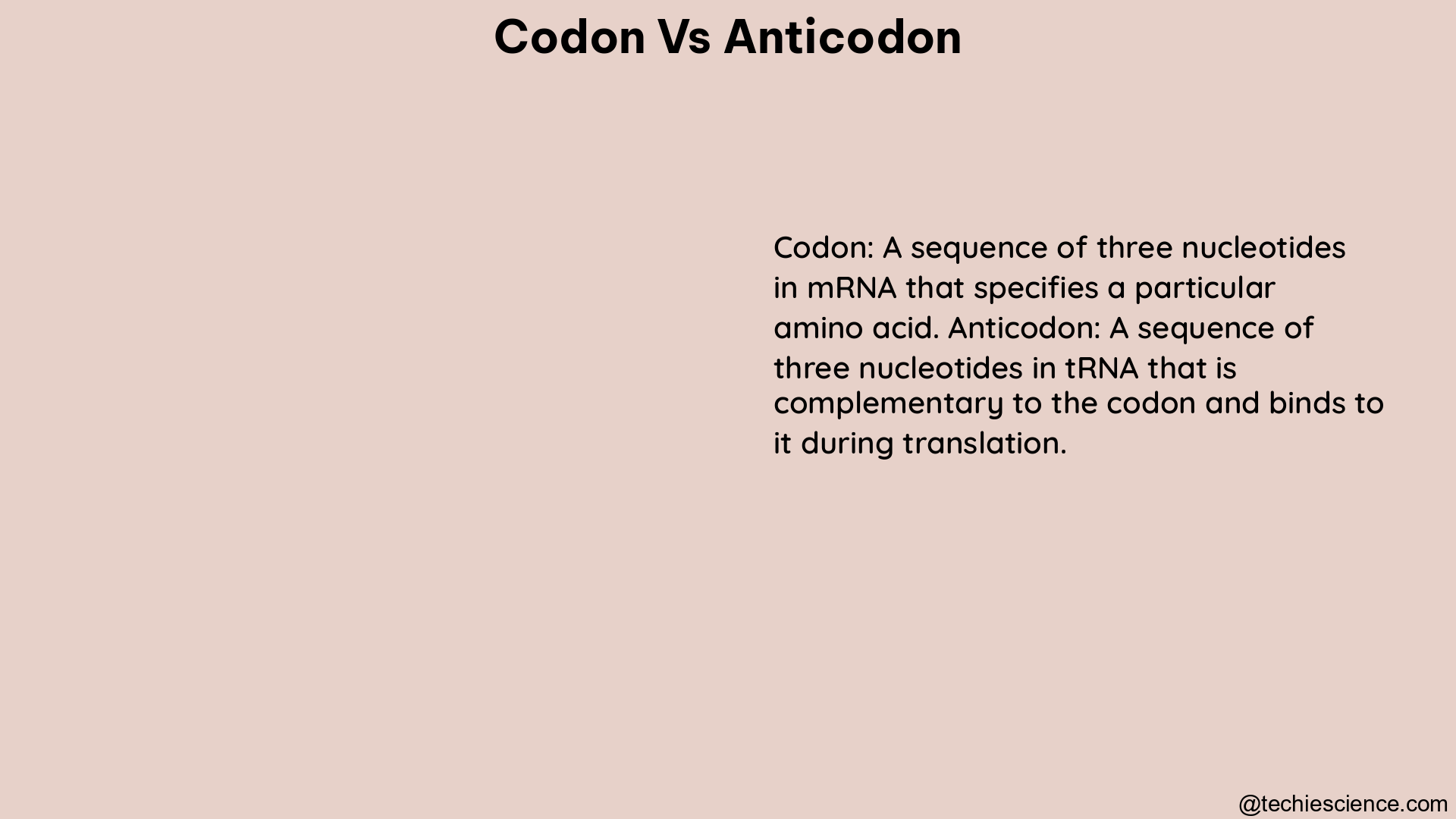Codons and anticodons are the fundamental players in the intricate process of protein synthesis, orchestrating the translation of genetic information into functional proteins. These two crucial components work in tandem, with codons specifying the amino acid sequence and anticodons recognizing and binding to these codons, ensuring the accurate assembly of the polypeptide chain.
Understanding Codons
Codons are triplets of nucleotides within the messenger RNA (mRNA) molecule that serve as the genetic code, each one specifying a particular amino acid or a stop signal. These three-nucleotide sequences are the building blocks of the genetic language, with 64 possible codons (4^3) representing the 20 standard amino acids and the three stop codons (UAA, UAG, and UGA).
The codon table, a comprehensive reference, illustrates the relationship between the 64 possible codons and the corresponding amino acids they encode. This table is a valuable tool for understanding the redundancy of the genetic code, where multiple codons can specify the same amino acid, a phenomenon known as codon degeneracy.
Deciphering Anticodons

Anticodons, on the other hand, are the complementary triplets of nucleotides found in transfer RNA (tRNA) molecules. These anticodons recognize and bind to the corresponding codons on the mRNA, bringing the appropriate amino acid to the growing polypeptide chain. The specific pairing between codons and anticodons is governed by the rules of complementary base pairing, where adenine (A) pairs with uracil (U) or thymine (T), and guanine (G) pairs with cytosine (C).
The anticodon loop, a crucial structural feature of tRNA, houses the anticodon sequence. This loop is responsible for the recognition and binding of the anticodon to the complementary codon on the mRNA, ensuring the accurate delivery of the correct amino acid.
Codon-Anticodon Interactions and Translation Accuracy
The interplay between codons and anticodons is central to the translation process, where the genetic information encoded in the mRNA is faithfully converted into a functional protein. The strength and specificity of the codon-anticodon interactions play a crucial role in determining the accuracy and efficiency of this process.
Factors Affecting Codon-Anticodon Interactions
-
Codon-Anticodon Pairing Strength: The stability of the codon-anticodon interaction is influenced by the strength of the hydrogen bonds formed between the complementary nucleotides. Strong codon-anticodon pairs, such as those with G-C base pairs, tend to have a lower frequency of translational misreading errors, while weaker pairs, such as those with A-U base pairs, are more prone to errors.
-
Anticodon Loop Modifications: Modifications in the anticodon loop of tRNAs can affect the frequency of translational misreading errors. Studies have shown that modifications that weaken the codon-anticodon pairing can increase the likelihood of misreading, while modifications that strengthen the pairing can decrease the error rate.
-
tRNA Availability: The availability of specific tRNAs with the appropriate anticodons can influence the efficiency of codon-anticodon interactions. If a particular tRNA is scarce, the corresponding codon may be more prone to misreading, as alternative tRNAs with less-than-perfect anticodon matches may be recruited.
-
mRNA Stability: The stability of the mRNA molecule can also impact the efficiency of codon-anticodon interactions. Factors such as mRNA secondary structures and the presence of regulatory elements can affect the accessibility of codons, influencing the rate of translation and the overall efficiency of the process.
Empirical Evidence and Theoretical Explanations
Numerous studies have investigated the impact of codon-anticodon interactions on translation accuracy and efficiency. For instance, a study published in Nucleic Acids Research demonstrated that the frequency of translational misreading errors in E. coli is largely determined by tRNA competition and the strength of codon-anticodon pairing.
Another study, published in Genetics, explored the effect of mutation and selection on codon adaptation in Escherichia coli bacteriophage. The researchers found that highly expressed genes tend to have a higher degree of codon adaptation, suggesting that codon-anticodon adaptation can influence translation efficiency and protein production.
The codon-anticodon adaptation theory provides a theoretical framework for understanding the co-evolution of codon usage and tRNA anticodons. This theory posits that these two components adapt to each other to optimize translation efficiency and accuracy, as evidenced by the strong relationship between codon adaptation and gene expression, as well as the impact of experimentally modified codon usage on protein production.
Factors Affecting the Efficiency of Codon-Anticodon Interactions
The efficiency of codon-anticodon interactions can be influenced by various factors, including tRNA availability, mRNA stability, and the presence of modified nucleotides in the anticodon loop of tRNAs.
tRNA Availability and Codon Bias
The availability of specific tRNAs with the appropriate anticodons can have a significant impact on the efficiency of codon-anticodon interactions. Highly expressed genes tend to use codons that are more frequently recognized by the available tRNAs, a phenomenon known as codon bias. This adaptation helps to optimize translation efficiency by ensuring that the appropriate tRNAs are readily available to bind to the corresponding codons.
mRNA Stability and the Codon Stabilization Coefficient (CSC)
The stability of the mRNA molecule can also affect the efficiency of codon-anticodon interactions. The Codon Stabilization Coefficient (CSC) is a metric that can be used to account for mRNA stability dynamics and relate the codon preference of a given coding sequence (CDS) to its translatability in a specific condition. By considering mRNA stability, the CSC provides a more comprehensive understanding of the factors that influence the efficiency of codon-anticodon interactions and, ultimately, protein production.
Modified Nucleotides in the Anticodon Loop
The presence of modified nucleotides in the anticodon loop of tRNAs can also influence the efficiency of codon-anticodon interactions. These modifications can affect the stability and specificity of the codon-anticodon pairing, with implications for translation accuracy and efficiency.
Conclusion
Codons and anticodons are the fundamental components of the translation process, working in concert to ensure the accurate and efficient conversion of genetic information into functional proteins. The intricate dance between these two elements is governed by a complex interplay of factors, including codon-anticodon pairing strength, tRNA availability, mRNA stability, and the presence of modified nucleotides in the anticodon loop.
By understanding the nuances of codon-anticodon interactions and the various factors that influence their efficiency, researchers and students can gain valuable insights into the mechanisms of protein synthesis, with potential applications in fields such as molecular biology, biotechnology, and synthetic biology.
References
- Näsvall, J., Sun, L., Roth, J. R., & Andersson, D. I. (2012). Real-time evolution of new genes by innovation, amplification, and divergence. Science, 338(6105), 384-387.
- Gingold, H., & Pilpel, Y. (2011). Determinants of translation efficiency and accuracy. Molecular systems biology, 7(1), 481.
- Presnyak, V., Alhusaini, N., Chen, Y. H., Martin, S., Morris, N., Kline, N., … & Coller, J. (2015). Codon optimality is a major determinant of mRNA stability. Cell, 160(6), 1111-1124.
- Novoa, E. M., & Ribas de Pouplana, L. (2012). Speeding with control: codon usage, tRNAs, and ribosomes. Trends in Genetics, 28(11), 574-581.
- Grosjean, H., & Westhof, E. (2016). An integrated, structure-and energy-based view of the genetic code. Nucleic acids research, 44(17), 8020-8040.

Hi…I am Sadiqua Noor, done Postgraduation in Biotechnology, my area of interest is molecular biology and genetics, apart from these I have a keen interest in scientific article writing in simpler words so that the people from non-science backgrounds can also understand the beauty and gifts of science. I have 5 years of experience as a tutor.
Let’s connect through LinkedIn-